CEBAF Inventors Receive the Ultimate Reward
Users Group Chair
CEBAF'S Summer High School Interns Excel
Volunteers Answering the Call of Need
Exposed to the Wonders of Science:
State Fair proves excellent vehicle to introduce thousands to CEBAF
Dedication Date Changed
Surf's up! NASA Internet Fair II
CEBAF Golf Classic Scheduled
MOU Signed with New Mexico State
Caring for CEBAF's Most Valuable Resources
Price Increases for Services Rates for Rooms, Entrees to Rise
Patents
CEBAF Inventors Receive the Ultimate Reward
Whether it is a pat on the back or a bonus check, receiving recognition for good job performance is always rewarding. Perhaps, the greatest recognition of all, however, is to be awarded a U.S. Patent. This document grants the recipient the exclusive rights to produce or sell an idea or invention for a specified period of time.
Due to the inventiveness of the staff and the various experimental research projects that are conducted at CEBAF, the awarding of patents has almost become a common occurrence.
Jean Delayen and Ganapati Myneni, both of the Accelerator Division, are among the recipients of patents at CEBAF .
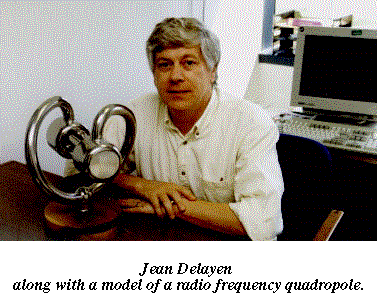 Delayen received his patent for work done while at the Argonne National Laboratory. Along with co-worker Ken Shepard, Delayen discovered a new way to design Radio Frequency Quadropoles (RFQ's) that would make optimal use of superconducting technology.
Delayen received his patent for work done while at the Argonne National Laboratory. Along with co-worker Ken Shepard, Delayen discovered a new way to design Radio Frequency Quadropoles (RFQ's) that would make optimal use of superconducting technology.
RFQ's are devices which take large quantities of low-energy ions and simultaneously focus and accelerate them into a higher-energy beam. The problem with the old RFQ design is that they are constructed of precisely made components which must be assembled to high tolerances.The result is a need for complex adjustment mechanisms to achieve proper alignment.
"By using a new geometry in regards to the design, we were able to create an RFQ that is more robust, which means it is more stable and insensitive to fabrication inaccuracies," says Delayen. "The RFQ is important to accelerator physics because it is the only structure which can focus, bunch, and accelerate high-current ion beams at the same time," he adds.
Receiving a patent is an honor for Delayen who says it has given him the feeling he has left his mark in the field of accelerator physics. "The fact that the University of Chicago, which runs Argonne Lab, felt that the design was worth the effort to apply for a patent, has made me feel that I have accomplished something," he says.
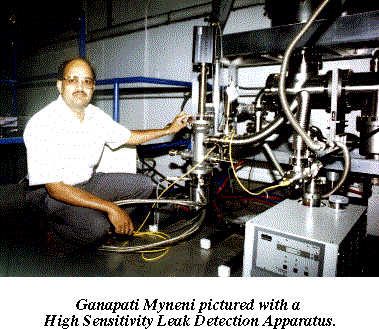 Myneni already has two patents for designing a cryogenic liquid level measuring apparatus and a high-sensitivity leak detection apparatus. His third invention has been approved. The invention which he co-created with Peter Kneisel, also of the Accelerator Division, concerns the use of metal sponges in the cryosorption pumping of hydrogen and helium in liquid-helium cooled clean beam line vacuum systems.
Myneni already has two patents for designing a cryogenic liquid level measuring apparatus and a high-sensitivity leak detection apparatus. His third invention has been approved. The invention which he co-created with Peter Kneisel, also of the Accelerator Division, concerns the use of metal sponges in the cryosorption pumping of hydrogen and helium in liquid-helium cooled clean beam line vacuum systems.
The metal sponges which are fabricated from aluminum oxide are able to enhance the pumping capacities of cryopumps at low pressures while maintaining the required pumping speed and dust-free environment when used as cryopanels. They can also be used as radiation shields for cryostats. To Myneni, a patent is not only a means of recognition, but it is also a way to safeguard from those who would try to prosper from his ideas and inventions without the proper permission.
"A previous employer had declined to apply for a patent for a device I created, but now similar devices are being produced by that company and others without including me in the profits," says Myneni.
SURA's policy regarding patents is one that benefits the organization and the inventor. According to Rhonda Shields, CEBAF Staff Attorney, obtaining a patent can be a time consuming and costly endeavor. "The process can take several years and cost thousands of dollars. SURA applies for the patent and when it is awarded, SURA takes title while giving credit to the inventor," says Shields. Once administrative costs have been paid, SURA equally splits the royalties from the patent with the inventor, she adds.
Although Myneni admits that he did not conceive the original concepts for some of his inventions, he thinks that it is his ability to bring the idea to life which is deserving of the patent. "Many inventions come from ideas that have already been formed. The idea is the easy part, but it is the thought, research, and effort that goes into making an idea a reality that deserves recognition," he says.
Patent Holders at CEBAF
- Isidoro E. Campisi
(1992) Wide-band Cryogenic Ultra-high Vacuum Microwave Absorber - Jean Delayen and Kenneth Shepard
(1995) Radio Frequency Quadropole (new design) - William J. Van Dyke
(1992) Fast Valve - Javier Gomez, Andrew Weisenberger, Stan Majewski
(1992) Non-Cross Talk Multi-channel Photomultiplier Using Guided Electron Multipliers - Ganapati Myneni
(1991) Cryogenic Liquid-Level Measuring Apparatus and (1994) High-Sensitivity Leak Detection Method and Apparatus - Ganapati Myneni and Peter Kneisel
(1995) Metal Sponge for Cryosorption Pumping Applications
David Ellis, Director's Office Intern
 Larry Dennis:
Larry Dennis:
Users Group Chair
Larry Dennis' connection with CEBAF spans nearly ten years of interactions on every conceivable level. As a Physics professor at Florida State University (FSU), researcher, and CEBAF's Users Group Chair, Dennis recognizes that CEBAF must serve the missions of many in the advancement of science.
Dennis is responsible for the coordination and identification of resources for CEBAF's community of scientists, researchers, teachers, and students known as "users."
"The Users Group is very diverse and produces innovative ideas regarding the best use of CEBAF," says Dennis.
The Group has received a multitude of proposals for experiments as the laboratory's reputation becomes known in the scientific community says Dennis.
"The fact that CEBAF is on budget, on time, and achieving identified objectives has instilled a great sense of confidence in the [scientific] community about its capability as a forefront scientific device," adds Dennis.
His involvement with the group is another in a series of positions he has held during CEBAF's construction and development.
While teaching at FSU in 1986, Dennis served as the Hall B Program spokesman. In 1990, Dennis was elected to Chair the CEBAF Large Acceptance Spectrometer Coordination Committee and served four years in that position.
After graduating from the University of Virginia in 1979 with a Doctorate in Physics, Dennis conducted post-doctoral work at FSU until joining the faculty at the university in 1980. Recently, Dennis has been working with engineers and computer scientists at FSU to develop data processing software for CEBAF's accelerator. The software will process the equivalent of one million computer disks of data daily. Development of the software has posed some unique challenges.
"The biggest challenge is finding a way to manage all the data the accelerator will produce," says Dennis. The group's software will use parallel processing (where multiple computers process data concurrently) to manage the massive amounts of data produced through accelerator experiments. So far, Dennis' group has achieved parallel data processing using 60 computers. He expects the software will be ready for use by early 1996 as CEBAF transitions from development to experimentation. Dennis is eagerly anticipating his participation as both researcher and Users Group Chair during operation.
"The reason I became involved in CEBAF is because I really enjoy research. I can't wait to get my hands on data that CEBAF will produce. Additionally, the role [of the Users Group] will be increasingly relied upon to represent an ever-increasing population of users. The group will work to make CEBAF as accessible to users while working to ensure that the user's research contributes to CEBAF's overall standing and mission," says Dennis.
Will Conners, Director's Office Intern
CEBAF's Summer High School Interns Excel
F or most high school students Summer is traditionally the season of idle leisure or an unfulfilling job.
Fortunately, this characterization in no way describes the 20 area students who worked at CEBAF through the Summer High School Student Internship Program. For many like Mike Madison, a rising senior at Bruton High School in Williamsburg, the internship was an opportunity to exercise his potential in pursuit of project research.
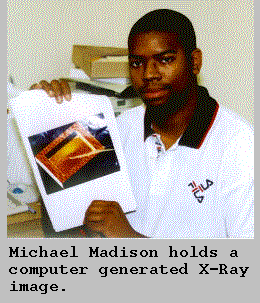 Under the tutelage of a CEBAF mentor-scientist, Madison researched ways to make X-ray images clearer. In a standard X-ray imaging arrangement, a "source" projects photons toward an object. The photons are received by a detector located on the opposite side of the object. Madison utilized a computer program to simulate the process to quantify how many photons were reaching the detector section of a simulated X-ray. The research will lead to advances in clearer more accurate images.
Under the tutelage of a CEBAF mentor-scientist, Madison researched ways to make X-ray images clearer. In a standard X-ray imaging arrangement, a "source" projects photons toward an object. The photons are received by a detector located on the opposite side of the object. Madison utilized a computer program to simulate the process to quantify how many photons were reaching the detector section of a simulated X-ray. The research will lead to advances in clearer more accurate images.
Madison says that obstacles were a welcome part of the research because of excellent CEBAF mentor support. "Whenever I ran into a problem, I would take a few minutes to think it through to see if I could solve the problem myself. If I still did not get it, I could ask for my mentor and he would be there to help in two seconds," says Madison.
Madison says that his exposure to valuable computer experiences while at CEBAF will be beneficial as he strives to achieve a career goal of becoming a computer game creator.
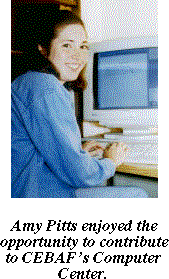 University of Michigan Freshman Amy Pitts also expects to draw from her internship experience in future endeavors. Pitts, a recent graduate of Hampton High School, is studying Naval Architecture and Marine Engineering in preparation for a career as a ship designer. Her internship in the Computer Center consisted of familiarizing herself with various computer applications and drafting user manual handouts for lab-wide use. "The internship really was an opportunity to use software I had never used before while improving my writing and editing skills," says Pitts.
University of Michigan Freshman Amy Pitts also expects to draw from her internship experience in future endeavors. Pitts, a recent graduate of Hampton High School, is studying Naval Architecture and Marine Engineering in preparation for a career as a ship designer. Her internship in the Computer Center consisted of familiarizing herself with various computer applications and drafting user manual handouts for lab-wide use. "The internship really was an opportunity to use software I had never used before while improving my writing and editing skills," says Pitts.
BEAMS Teacher Program Manager Bill Williams says that the environment of CEBAF's internship program encourages each student to build upon past accomplishments through individual contributions to project research. "The internship program is a unique educational outreach effort with a two-pronged objective. Students are immersed in the pursuit of scientific research while at the laboratory, and the student's efforts naturally benefit CEBAF's mission," says Williams.
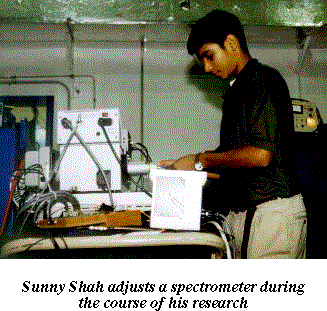 Acceptance into the program is highly competitive. Seventeen of this past year's students completed application packages that were reviewed by a panel of mentors, and the departments of Human Resources, and Project Management for selection and placement. Three remaining students like Sunny Shah were awarded internships based on their achievement of awards in area Science Fairs.
Acceptance into the program is highly competitive. Seventeen of this past year's students completed application packages that were reviewed by a panel of mentors, and the departments of Human Resources, and Project Management for selection and placement. Three remaining students like Sunny Shah were awarded internships based on their achievement of awards in area Science Fairs.
Shah's internship focused on the "grading" of fiber optic cables and work on the spectrometer. "This place is great because everything is science-related. The people I worked with were willing to explain anything," says Shah. Shah says that his internship not only expanded his experience with computers, but also enabled him to participate in scientific processes. "My experience was good because I saw firsthand what it was like to research and work at a place like CEBAF," says Shah.
Will Conners, Director's Office Intern
Volunteers Answering the Call of Need
The heat, the smoke, the loss of spatial orientation. These are the enemies of firefighters according to CEBAF technician and volunteer firefighter Frank Folsom. "It can get unnerving. You don't know where you are. You can't see where you are going, but you know that someone in there needs to be found," he says. Folsom is one of many at CEBAF who spend off-duty hours volunteering time and effort to improve their communities.
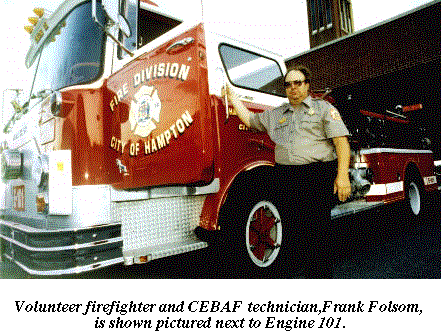 Folsom has been a volunteer at Hampton's oldest volunteer fire company, Station Number One, for over 23 yearsrising from the position of fireman to First Lieutenant. Folsom coordinates the logistics of personnel and equipment when fighting fires.
Folsom has been a volunteer at Hampton's oldest volunteer fire company, Station Number One, for over 23 yearsrising from the position of fireman to First Lieutenant. Folsom coordinates the logistics of personnel and equipment when fighting fires.
In addition to gaining satisfaction from "helping the city and his fellow man," Folsom says that volunteer activities are socially beneficial. "We travel to conventions which are always a good chance to meet people and have a good time," he says.
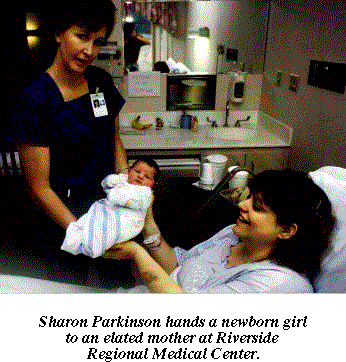 At the nursery of Riverside Regional Medical Center, Sharon Parkinson of Project Management, invests her time in one individual at a time.
At the nursery of Riverside Regional Medical Center, Sharon Parkinson of Project Management, invests her time in one individual at a time.
According to Riverside's volunteer office, Parkinson has accrued more than 320 hours over four years volunteering in the hospital's nursery. Once a week she assists nurses with feeding, bathing, and changing newborn babies. "Its nice to be a part of so much happiness. It is especially wonderful to watch how new parents react when they hold their baby for the first time. They are always in awe," she says.
Staff Services Manager, Julie Leverenz, also views her volunteerism as an investment in the community.
Leverenz has served nine years as a board member for the United Way of Greater Williamsburg. Her efforts have contributed to directing the flow of United Way funds that support over 40 area programs. She says that her experience in the United Way has had the unexpected effect of expanding her management skills. "Through team coordination of resources, I learned more about management concepts like strategic planning processes," says Leverenz. Her volunteerism in a managerial capacity has not isolated her enthusiasm from the ultimate focus of community service.
"My experience has been very personal. It [volunteering] has been a way to become connected to the community and learn more about its needs. The board is great because you don't have to be a company president to serve on it. Terms are limited and the nominations process encourages a diverse board to better represent and serve the community," says Leverenz.
Will Conners, Director's Office Intern
Exposed to the Wonders of Science:
State Fair proves excellent vehicle to introduce thousands to CEBAF
T he exclamation, "CEBAF? I always passed the sign on I-64 and wondered what it meant," wasn't the only frequent statement pronounced by visitors of CEBAF's display at the Virginia State Fair's Commonwealth Technology Center. The other was: "Wow!"
"People really enjoyed and were interested in the exhibits; and the cryoshows were a big hit," says Diane Anderson, CEBAF's Compensation and Benefits Manager, who worked two shifts. The many questions fired at workers made for many busy days. Anderson took it all in stride. "It made me feel proud of CEBAF. It was neat to pass on the mission and that CEBAF is worthwhile," she said.
Joining other exhibitors in the high-tech building, including NASA, MCI, Bell Atlantic and the Virginia State Police, CEBAF stood out by drawing large crowds to more than one hundred Cryogenics performances in an eleven day period (September 21-October 1, 1995). The Center iself attracted more than 200,000 visitors.
"Once they saw the plumes of fog, they realized 'Wow! Something wild is going on over there," said Steve Gagnon, an education activities technician at CEBAF who performed a number of the shows at the fair.
Cryogenic Shows were just a portion of the excitement, however. People from all over Virginia and neighboring states, poured into the Center to experience what CEBAF had to offer at the fair. CEBAF's exhibit included:
a test of strength against a powerful magnet,
displays and handouts outlining CEBAF's mission and outreach programs,
learning more about the atom on a computer program, and
designing colorful disk with color spinners and markers.
"The State Fair was a very positive experience for all who participated," says Linda Ware, public information officer. "It was very gratifying for people to ask us what that sign meant on I-64. And it was also a great way to introduce CEBAF to a large number of citizens in Virginia."
Thanks State Fair Volunteers!
We couldn't have done it without you.
Diane Anderson, Teresa Beatty, Marti Bennett, Bob Bennett, George Biallas, Ruth Bizot, Jim Boyce, Skip Callis, Milissa David, Dave Ellis, Tim Fox, Debbie Fredette, Steve Gagnon, Joe Grames, Eric Hanson, Lee Harwood, Tom Hassler, Marty Hightower, Karen Hokansson, Tammy Hudson, Deborah Hyman, Brian Kross, Jim LeMaire, Donna Lewis, Danny Lloyd, Anthony Magaldi*, Kelly Mahoney, Pete Markowitz, Ed Martin, Bob May, Erica Murray-Hirabayashi, Ganapati Myneni, Manny Nevarez, Sheila Norman, Sharon Parkinson, Janet Prater, Scott Schwahn, Michelle Shinn, Will Sommer, Mary Beth Stewart, Debra Stitts, Ed Stitts, Lisa Surles, Mike Syptak, Janet Tyler, Skip Tyler*, Linda Ware, Drew Weisenberger, Bill Williams, Mark Wissmann, Randy Wojcik
*not a CEBAF employee
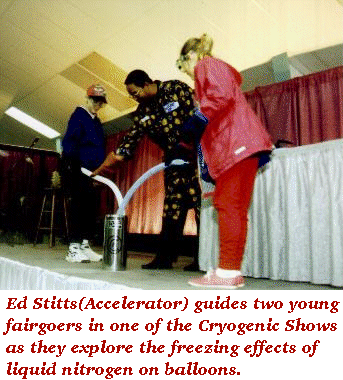 |
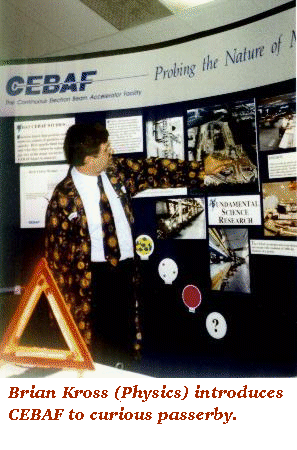 |
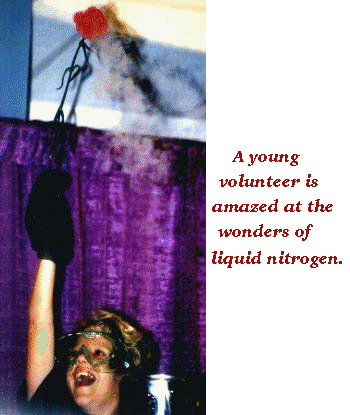 |
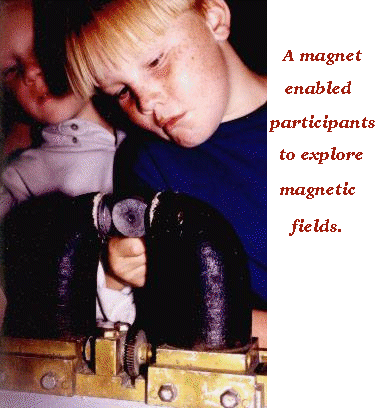 |
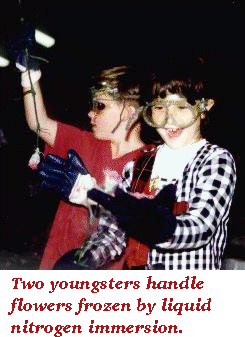 |
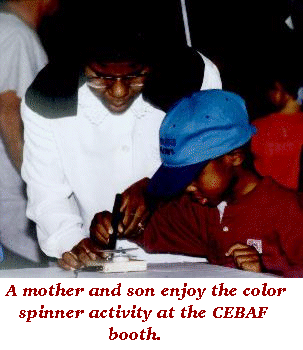 |
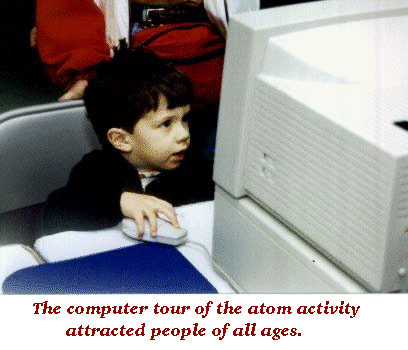 |
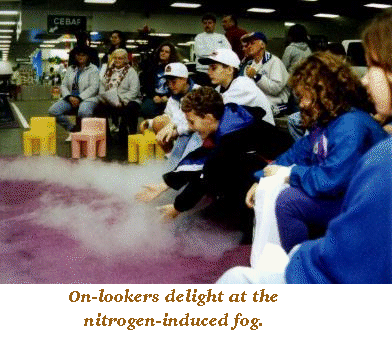 |
Text and photos by Deborah Hyman and David Ellis.
BRIEFLY...
Dedication Date Changed
The date of the CEBAF dedication scheduled for October 27, 1995, has been changed. Information on the new date will be forthcoming
Surf's up! NASA Internet Fair II
With October comes cold weather, but there is still time to do some hard-core surfingon the Internet that is. October 23 and 24, NASA will hold its second annual Internet Fair between 9 a.m. and 4:30 p.m. at the Reid Conference Center.
The focus of the fair is to give NASA the chance to exchange information technology with Hampton Roads area organizations and to discuss how this technology can be used in education, business, media, and entertainment to benefit the community.
CEBAF will join NASA and other organizations from across the Peninsula including Christopher Newport University, Newport News Shipyard, and the U.S. Army. Each will demonstrate their use of the Internet and other technologies.
For more information on Internet Fair II, contact Karen Hokansson at ext. 4861 or by e-mail at kchok@jlab.org.
CEBAF Golf Classic Scheduled
The Employee Recreation Committe has planned the first CEBAF Fall Classic. The tournament will take place at noon, October 28th, at The Pines Golf Course located on Fort Eustis.
The $30 fee includes greens fees, golf cart rental, and beverage. Money is due October 13. All player abilities are welcome. Sign up at the CEBAF Center reception desk. Spaces are limited. For more information contact Eric Woodworth at ext. 7217.
MOU Signed with New Mexico State
CEBAF University Relations Head, Nathan Isgur, was on hand September 19th to participate in a partnership signing ceremony with representatives of New Mexico State University in Las Cruces, New Mexico.
The agreeement, coordinated by Isgur, will enable NMSU to add three new faculty scientists to their department to conduct research at CEBAF. They are Matthias Burkardt from the University of Washington; Vassilios Papavassiliou from the Illinois Institute of Technology and Fermi Laboratory; and Stephen Ford Pate of the Massachusetts Institute of Technology.
George Burleson, head of NMSU's physics department said, "We will be able to do experiments we have not been able to do before, to explore regions of energy between high energy and low energy. We want to see how the two pictures merge, and this will give us more information about quark structure."
The three new faculty members will divide their time between teaching at NMSU and conducting research at CEBAF.
From the Ashes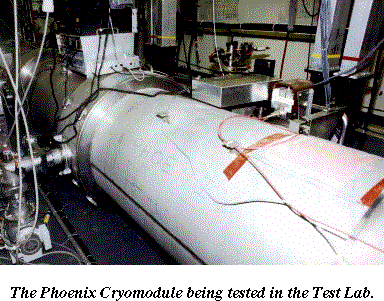
Phoenix. To the ancient Egyptians it was a 500 year-old bird that set itself on fire, only to rise renewed from the ashes. CEBAF's first full production crymodule, "Phoenix," has also traveled a path of rejuvenation and rebirth like its Egyptian namesake. The crymodule was created in 1989 from parts of two existing crymodules that were no longer usable.
After 5 years of operation, Phoenix is being tested in the Test Lab by the SRF group. Findings will be used to alter future crymodule designs for gains in efficiency and durability.
"Phoenix is going through a complete round of testing that will allow us to understand the effects of operation on the crymodule. We can then develop processing techniques that will lead to increased performance and higher levels of achievable accelerator energy," says Staff Engineer Joe Preble of the Accelerator Division. Preble who originally named Phoenix, oversaw the crymodules's fabrication and is now coordinating the test effort.
Tests include: Quality Factor checks, probe sensing calibrations, RF and Vacuum systems evaluation, and research into changes in cryogenic performance that have occurred in the course of repeated operations. In the future, each crymodule will be disassembled to its smallest component, reworked, reassembled, and returned to operation in the accelerator.
Evaluation and testing of the cryomodules will be conducted in the Test Lab. Preble says removal of the cryomodule from the accelerator ensures that the accelerator itself will not be damaged in the course of testing. In addition external testing of crymodules allow work to be conducted without interruption of accelerator operation.
The accelerator has a total of 42 and one fourth crymodules consisting of 40 in linear accelerator sections, and two and one fourth in the injector. Ultimately, CEBAF will have two spare crymodules in reserve to install in place of those removed for reworking.
Will Conners, Director's Office Intern
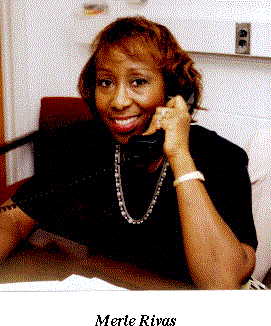 Caring for CEBAF's Most Valueable Resources
Caring for CEBAF's Most Valueable Resources
To work in the Human Resources Department, one must be able to assume the roles of policy-maker, confidant, and referee. More importantly, one must enjoy working with people. Merle Rivas, CEBAF's new Employee Relations Manager, says she is just that type of person.
Having started out in the field of economics, Rivas describes her entrance into Human Resources as unusual. "I often say that I came into Human Resources through the back door.I was working as an economics research analyst in a research and development organization when the group was disbanded because of lack of follow-on funding. Fortunately, I was given some options which led to me working for their Human Resources Department," she says. "I soon realized that I actually loved the job and I was able to move up into management positions."
Rivas has a Bachelor's of Arts degree in Economics from Howard University. She also has a Certificate in Personnel Studies from the Cornell University New York School of Labor and Industrial Relations. She came to CEBAF after her husband, Ken, moved his business into the area.
Establishing new programs, creating and implementing policies, and over-seeing manager-employee relations are just a few of Rivas' responsibilities. When asked why she enjoyed working in this field, Rivas replied,"I like the opportunity to work people issues, because they are often dynamic and never routine. I also believe that my position enables me to make a contribution to the quality of work-life while helping the organization accomplish its mission."
Rivas says she believes in keeping her door open to anyone who needs her help or advice.
By taking what she learns from moderating disputes between supervisors and workers, Rivas strives to create a more productive and satisfactory working environment for all. "I am here to support management and employees and to contribute to the successful management of one of our most valuable resources, our people. I also must remain unbiased, when dealing with people issues, to guarantee that everyone feels that they are being treated fairly," she says.
Rivas is working on a new performance appraisal policy in addition to familiarizing herself with CEBAF. On her desk is an ever-growing "need to know" file of CEBAF offices and personnel who she feels have the "pulse" of employee relations issues. Through these sources, Rivas contends that she will be able to determine what areas of employee relations are most important to CEBAF personnel, along with which policies work and which ones need improvement.
Rivas says that an open line of communication between employees and management in any company is the key to success. Therefore, maintaining this communication at CEBAF is Rivas' primary concern. "If I am having to deal with too many employee grievances, than this department is not doing all it should. However, if we can provide and continue an atmosphere of open communication, then everyone should feel comfortable in their working environments and that would mean that we have done our jobs," says Rivas.
David Ellis, Director's Office Intern
United Way News
T he 1995 United Way fundraising Campaign has officially commenced. Shilda Williams, CEBAF's United Way Coordinator, announced CEBAF's fundraising goal of $32,000 during October 16-October 30. "I know the employees of CEBAF will recognize the needs of the community and generously respond as they have in years past," says Williams.
Contributors to the campaign earmark their contribution to any one of 40 services and programs that the United Way provides the community. In addition to the campaign,12 CEBAF employees recently participated in the Annual United Way's Day Of Caring on September 7th. The employees volunteered their day and worked in various organizations. Numerous organization's benefited from the volunteers efforts including the Boy Scouts of America and the Big Brothers/Big Sisters Program. Volunteer Carolyn Camp said "Day of Caring is a very good program. It helps the organizations and fills a need."
Day of Caring Volunteers
Skip Callis, Carolyn Camp, Robin Cowherd, Tom Dunn, Dave Kausch, Sharon Parkinson, Chip Piller, Sandra Prior, Christine Snetter, Ernie Sommer, Ivy Thomas, Shilda Williams
Price Increases for Services:
Rates for Rooms, Entrees to Rise
Customers of the SURA Residence Facility and the Cafeteria will notice price increases soon. In an effort to fund construction of 16 additional rooms and to meet the costs of inflation, prices are simply going up.
"As CEBAF begins operations, we are expecting the number of guests wishing to stay at the Residence Facility to increase dramatically in the near future," said Julie Leverenz, Staff Services Manager.
Effective October 15, 1995, the daily room rate will increase from $27 to $30. "This is only our second rate increase since we opened the facility nearly six years ago, and our new rate is still less than those at even the lowest-priced commercial hotels in the area," said Leverenz. She adds that SURA, with help from its member universities and perhaps some User institutions, will furnish and decorate the new rooms as SURA institutions have done for the original 28 rooms.
Faced with rising food and labor costs in the cafeteria, operated by CRH Catering, Staff Services asked cafeteria patrons to help determine how to implement the first price increase since the cafeteria opened in March 1990. The choices were:
Vary the price of each entree based on individual cost, from a low of $2 to a high of $4.50 or
Increase entree prices across the board from the current $3.25 to $3.95.
"Eighty percent of the respondents told us," says Leverenz, "that they want to see a direct relation between the price and the entree itself instead of an average price. Therefore, starting next month, we will price the entree differently each day."
"We are trying to get an idea of what our customers in the cafeteria want. In fact, we are always interested in hearing suggestions. We try to be as responsive as we can," says Leverenz.
For more information, call Leverenz at ext. 7642.

